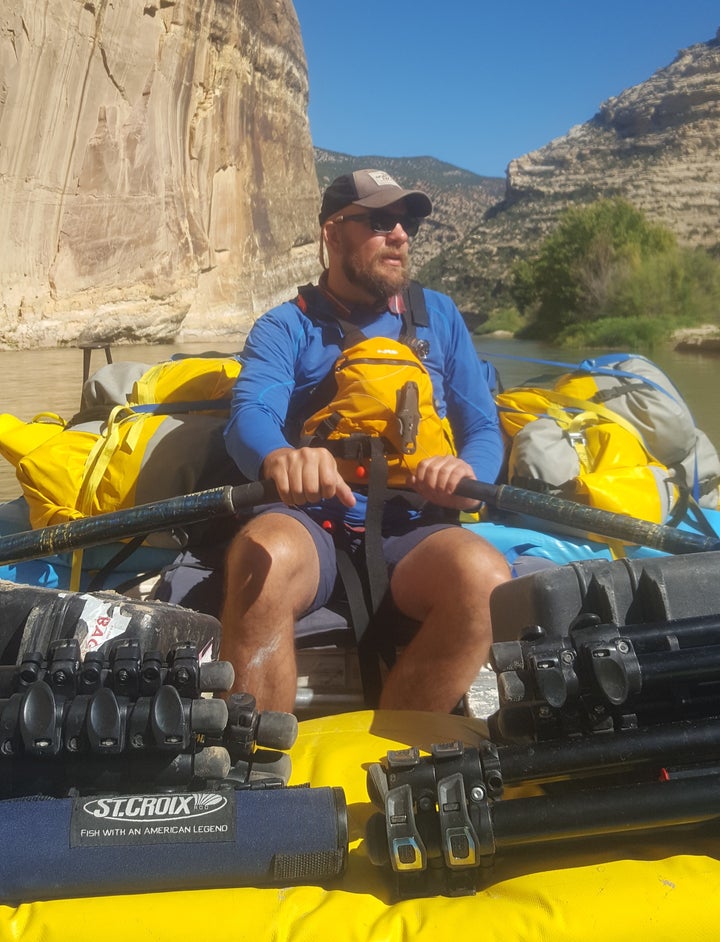
The author rowing into Echo Park on the Green River in Utah
Think about a time you’ve experienced awe. Where were you? Who were you with?
I find awe in the depths of a canyon on the river, when I gaze up at the night sky, during the first light of a dawn patrol skiing in the Wasatch Range in my back yard, and when I look at my daughter exploring our great outdoors. For her, everything is new, and I find myself more inspired when I see her face light up when we find ourselves in nature from the front yard to a national park, looking up under the canopies of trees reaching into the sky, watching fish break the surface at a swimming hole, or splashing on the banks of a river.
When talking about awe, writer Jordan Rosenfeld wrote, “Psychologists consider awe a form of ‘self-transcendence’: you temporarily blur at the edges, feeling a connection to something greater than yourself.”
In 2003, researchers Jonathan Haidt and Dacher Keltner published a landmark study on the social and emotional functions of awe. They found that awe appeared to increase people’s feelings of connectedness and willingness to help others. In their study, they wrote: “The consequences of awe should be of interest to emotion researchers and to society in general… Awe-inducing events may be one of the fastest and most powerful methods of personal change and growth.”
Over the past two summers we have successfully initiated a program of research to begin to test our own hypotheses that 1) outdoors experience improves physical, mental, and social well-being and 2) the emotion of awe is an important mechanism driving these effects.
In our research we found “Cortisol measured at the end of the white-water rafting trip is positively related to the positive emotions that people report experiencing during the trip. Our interpretation of this finding, given that white-water rafting is an intense, physically demanding activity, is that positive emotions are associated with a more adaptive hormone profile associated with mobilizing energy in the body. Cortisol levels after the rafting trip are in turn associated with increases in happiness levels measured at follow-up.” In addition, a preliminary analyses of veterans showed decreased levels of PTSD.
While the science and research backs it up, you don’t have to be a scientist to know the healing power of nature. It connects us to a world so much larger than ourselves.
So why aren’t we all clambering to get our daily injection of the good stuff we find outdoors? For most of us, especially kids, screens have replaced nature as entertainment and a place to connect. While technology has advanced our society in positive ways, we have become increasingly disconnected to the environment around us.
According to a 2015 study by Common Sense Media, American youth between the ages of 8 and 18 on average are logging 7.5 hours of screen time per day, and that’s not counting time spent using media for school or homework. Time spent outside? Just minutes.
“What could our lives and our children’s lives be like if our days and nights were as immersed in nature as they are in technology?” American author and journalist, Richard Louv, has spent more than a decade digging into the answers to this question. In his book, “Last child in the Woods: Saving Our Children From Nature-Deficit Disorder,” Louv explored the ever-growing disconnect between kids and the outdoors, and how it impacts their physical and emotional health. Through extensive research and examples Louv pointed out that epidemics like obesity, depression and attention disorders in our youth were largely to blame for a childhood that has moved inside and online. He coined it “nature-deficit disorder.”
While Louv stressed his findings were not medical, but rather a societal diagnosis, more and more pediatricians have turned to “lack of nature” as a partial explanation for the growing list of issues they’re seeing in their practices.
These findings are enough to inspire most people to put down their device and head outside. But for more motivation, veteran river outfitter, O.A.R.S., rolled out a new challenge for us all: Spend 100 hours unplugged and outside with your family this summer. The campaign, #100HourUnplugged, is aimed at encouraging families to trade screen time for more time outside.
“It’s clear that developing a balanced relationship with technology and spending more time outdoors is not only essential for children’s physical and emotional health, it’s the best way to ensure the long-term protection of our national parks and public lands,” Steve Markle, Vice President, Sales and Marketing for O.A.R.S. said. “Now, more than ever, we want to encourage kids and families to unplug and explore the great outdoors—whether that’s on a river trip or a backyard adventure.”
One hundred hours is about four days. It’s a long weekend or perhaps one day a week in July. And whether families regularly unplug or hardly ever unplug together, it’s totally doable. In setting out to launch this campaign, that’s what O.A.R.S. envisioned—a challenge that wasn’t completely out of reach for the average person. Because with such alarming statistics on technology use, and the ever-growing data behind the benefits of time spent outdoors, it’s clear that every single person, especially kids, could use a nature break, according to Markle. And I couldn’t agree more.
, 'Jp�d�